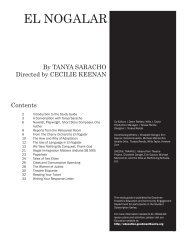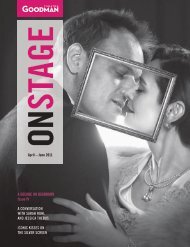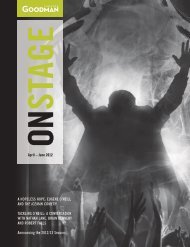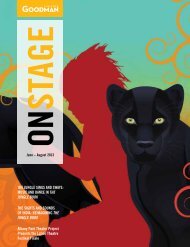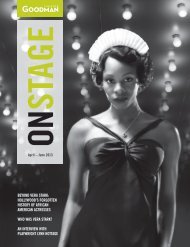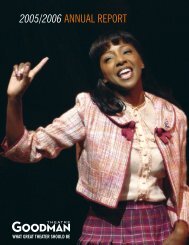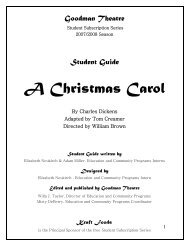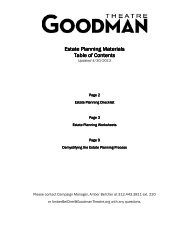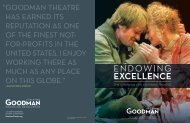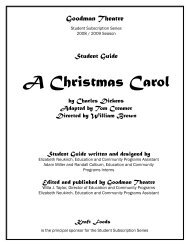Create successful ePaper yourself
Turn your PDF publications into a flip-book with our unique Google optimized e-Paper software.
The young are particularly likely to be drawn into a movement<br />
that represents an unconventional or unexplored aspect of<br />
their identity, and these types of social identity movements<br />
thrive on college campuses where self-discovery and freedom<br />
of expression are paramount.<br />
ments of their time, like advocating for<br />
workers’ rights, students in the 1960s<br />
fought for reform both in public policies<br />
that affected their generation, as well<br />
as issues relevant to campus life: they<br />
spoke out against the Vietnam War and<br />
its toll on their generation and pushed<br />
back against restrictions on personal<br />
freedom (particularly for women) and<br />
civil liberties imposed by institutions that<br />
saw it as their responsibility to provide<br />
students with moral guidance as well as<br />
an education. The student movements of<br />
the 1960s achieved mixed results, but<br />
they successfully established student protests<br />
as a permanent tool with which to<br />
achieve social and political change. And<br />
after the turbulent protests of the 1960s<br />
retreated into the history books, a whole<br />
new type of social movement begin to<br />
take over college campuses.<br />
While student movements through the<br />
end of the 1960s tended to focus on<br />
achieving specific changes within an<br />
institution—whether it be a university<br />
or the government—the new social<br />
movements that have emerged in later<br />
decades focus primarily on cultural issues<br />
and advocate for change within a society.<br />
These movements are typically built<br />
around a single broad theme, and strive<br />
to create a cultural environment that<br />
embraces the values and individuals that<br />
these groups represent, with the greater<br />
goal of achieving mainstream acceptance<br />
of a marginalized group or fringe issue.<br />
Often they form on behalf of a group of<br />
individuals with a shared common identity,<br />
like feminists or LGBTQ individuals,<br />
and work to alter the perception of that<br />
demographic both within the greater<br />
culture and within individual group members<br />
themselves. In such movements<br />
the goal is threefold: to clearly define<br />
the identity of their members on their<br />
own terms; to create an environment<br />
in which individuals can thrive as their<br />
most authentic, uninhibited selves; and<br />
to advocate for mainstream acceptance<br />
of new or unconventional lifestyles.<br />
Since the intention is to change the culture<br />
within a community rather than at<br />
an institutional level, new social movements<br />
are often built through grassroots<br />
micromobilization, with recruitment<br />
dependent on social networks and informal<br />
existing relationships among individuals<br />
of the group in question. Usually<br />
movements form spontaneously through<br />
the convergence of individuals with a<br />
common identity, and establish solidarity<br />
as individual members’ own sense<br />
of identity develops in tandem with the<br />
group identity as the collective struggles<br />
to boldly accept itself and define “who<br />
we are” as a group within a society.<br />
Often, the movements are so closely tied<br />
to the public identity of a demographic<br />
that participation is assumed, as Debra<br />
Friedman and Doug McAdam outline<br />
in their essay “Collective Identity and<br />
Activism: Networks, Choices, and the<br />
Life of a Social Movement”:<br />
“Most movements do not arise<br />
because isolated individuals choose<br />
to join the struggle. Rather, established<br />
groups redefine group membership<br />
to include commitment to the<br />
movement as one of its obligations;<br />
the threatened loss of member status<br />
is usually sufficient to produce high<br />
rates of participation. As a result,<br />
the movement is largely spared the<br />
need to provide selective incentives to<br />
attract participants.”<br />
The young are particularly likely to be<br />
drawn into a movement that represents<br />
an unconventional or unexplored aspect<br />
of their identity, and these types of social<br />
identity movements thrive on college<br />
campuses where self-discovery and freedom<br />
of expression are paramount. And<br />
although most universities aim to encourage<br />
self-discovery in students, social<br />
movements on campuses have always<br />
experienced push-back from administrators<br />
as the balance between allowing<br />
free speech and permitting destructive or<br />
distracting behavior on campus is continually<br />
in negotiation. Some universities<br />
implement “speech codes” that define<br />
the terms under which an institution permits<br />
various forms of demonstration and<br />
protest. While these codes are created<br />
as a well-intended tool to limit conflict<br />
and violence on campus, a 2011 study<br />
by the Foundation for Individual Rights<br />
in Education found that up to 65 percent<br />
of the colleges had inadvertently created<br />
policies that violated the Constitution’s<br />
protection of free speech. (Public universities<br />
are prohibited from limiting<br />
nondestructive free speech, while private<br />
institutions are granted more freedom<br />
with their speech codes.) And while<br />
students are free to organize and demonstrate<br />
as they choose, often even peaceful<br />
movements come into conflict with<br />
contemporary university administrations<br />
hesitant to draw attention to any degree<br />
of discontent on campus.<br />
New Work Fast Fact<br />
Between 2004 and 2011, the <strong>Goodman</strong>’s New<br />
Stages series offered staged readings of 45<br />
new plays. Of these, 34—including Teddy<br />
Ferrara—have gone on to full productions at<br />
the <strong>Goodman</strong> or elsewhere to date.<br />
<strong>Goodman</strong> <strong>Theatre</strong> would<br />
like to thank all New<br />
Work donors for their<br />
help in making this program<br />
possible.<br />
13



